Factors of glare
– a comprehensive list –
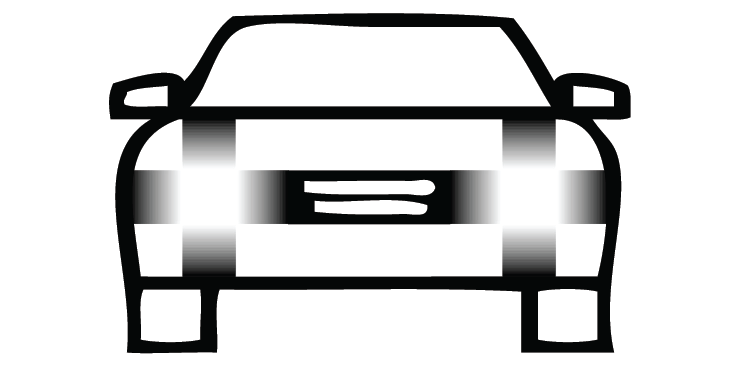
Here is an attempt to collect all factors of glare, with a primary focus on night-time traffic.
External (8) and internal (8) factors are listed with a short (and very incomplete) description.
- Luminous flux
- Solid angle
- Luminance / brightness
- Spectral power distribution / color
- Coherence
- Contrast
- Spectral power distribution of surrounding field
- Distribution of light intensity
- Dark adaptation
- Optical properties of the eye
- Gaze position
- Attention and cognitive context
- Overreliance on the blink reflex
- Sensitivity to pattern glare
- Color preference
- Filling-in effect
Introduction
This post aims to bring together all factors that play a role in glare, particularly from the viewpoint of night-time traffic / automotive lighting. In this context, disability glare (a hindrance in seeing) and discomfort glare (irritation by the visual scene) are usually defined and treated separately, as they are indeed affected by some of the factors differently. Here I will not make such distinctions and only describe each point with extreme brevity – they will be expanded in separate posts to follow. The list goes from obvious and frequently discussed to obscure; explanations are therefore somewhat longer for the latter.
I am writing this list because I have never seen one: most of the time, only a couple of these factors are mentioned at once. The list is likely not complete though – if you know what’s missing, please let me know!
Part 1:
Properties of the glare source (external factors)
1) Luminous flux
In general, an increase in luminous flux (the amount of emitted light as seen by the average human eye) leads to increased glare. “As seen by the average human eye” refers to the fact that in this process, different wavelengths are weighted differently (relative to the physical energy carried by them).
2) Solid angle
The smaller the source, the more likely it is to cause glare (given that luminous flux is the same). The lower limit to this is a “point” source. Below this relative size (1.5 mrad viewing angle) differences in solid angle are, by consensus, considered irrelevant.

While external optical limitations also play a role here, it is worth to note that the resolution of the eye is at least 5x better (0.3 mrad or less): so the above definition of what “point” means may not necessarily apply to every visual situation.
Also, a blink response is less likely to an overly bright source, when the resulting retinal image is small.
3) Luminance / brightness
Brighter is more glaring (in general, glare increases with the square of the source luminance). Factors 1-3 are of course interdependent (the same luminous flux from a larger surface means lower luminance, etc).

4) Spectral power distribution / color
But the definition of brightness – the perceptual aspect of luminance – is a complex question. The most commonly used function to estimate the human eye’s average sensitivity [V(λ)] is not so appropriate when it comes to glare, as in this case, shorter wavelengths play a relatively larger role. This means that colder ( = “bluer” = higher color temperature = more short-wavelength-dominant) sources cause more glare. The higher the light levels, the greater this difference.
“When a measure becomes a target…” sort of…
With modern HID and LED sources in automotive lighting, manufacturers have begun to target the bluest edge of the allowable color range for headlights (at times also exceeding it, see here and here) – a major change in the past two decades, contributing to an increase in complaints about glare. Also, more saturated colors are perceived as brighter: see point 5.
Primarily design considerations led to an interesting interaction between source size, luminance, and color: to decrease the diameter of headlamps, reflector optics are being replaced by projector lenses, which result in pronounced color separation at the edges of the beam. These developments affect glare unfavorably – while they also elicit unnecessary attentional orienting, since changes in viewing angle become linked to changes in color.
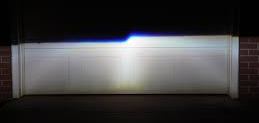
5) Coherence
Light can be coherent temporally (monochromatic light, i.e. light waves have the same frequency) or spatially (waves travel with identical phase), and a higher degree of coherence means greater potential for causing glare. Unfiltered sunlight or incandescent electric light is highly incoherent; some LEDs or lasers would be the other end of the spectrum, capable of producing highly coherent light in both dimensions. A perceptual manifestation of higher coherence is the presence of speckles, where positive interference between waves creates localized peaks in intensity (a glittery effect).
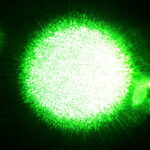
6) Contrast
A given light source will cause more glare if its surroundings are darker. Our visual system has evolved to perceive scenes with very low contrast, which is a product of natural lighting – largely irrespective of time of day or light levels. With electric light sources, extreme contrast can be achieved (particularly at night). Therefore, providing luminous surrounds to a light source (or raising ambient light levels of course) can decrease glare.
7) Spectral distribution of surrounding field
Curiously, such a luminous surround to the glare source has different effects depending on its own color: long wavelengths (warm colors) reduce glare better than short wavelengths.
8) Distribution of light intensity
Naturally, this point also incorporates the viewing distance, beam pattern, aim, and mounting position of a fixture (e.g. in case of a car headlamp, shorter viewing distance, higher aim, or greater mounting height result in more glare as oncoming traffic will fall under a more intense part of the beam). Below are some more general aspects of light intensity distribution.
[a] Light propagation in space
A light source with a curved surface (such as the sun, a fluorescent tube, the filament of a halogen lamp, etc.) spreads light in all directions. This means that the intensity of light drops the same way (proportionally to the square of the distance) around the source, in all directions. An LED chip, on the other hand, radiates light from a flat surface. Therefore, light intensity peaks along a line perpendicular to this surface (meeting the source at its center).
Such “directionality” or cosine distribution of LED light presents novel optical and perceptual challenges and advantages, affecting both glare and color perception. Unmitigated, its effects can also be seen from cues in the space that the source illuminates (e.g. edges and shadows appear sharper, dark parts of the scene remain relatively darker, spatial details may diminish or become exaggerated depending on their angle). When the light source is directly visible, this property increases glare. The above refers to light intensity distribution from the source itself – this can of course be further shaped by optical means.

[b] Uniformity and pattern of the luminous surface
Less uniform sources elicit more glare. This is particularly interesting when several lamps are combined in some configuration.
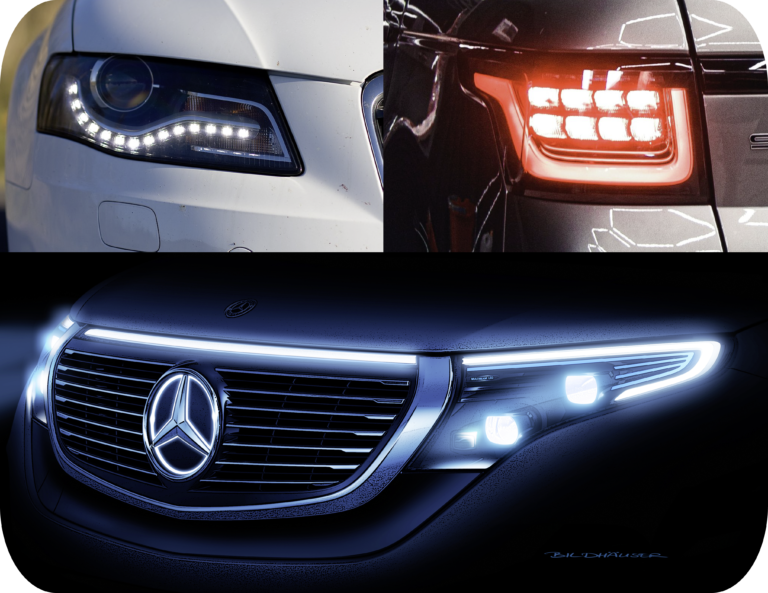
[c] Glare illusion
As a case of non-uniformity, this could also be included in the point above. It deserves separate mention though, since the mechanism behind it is probably distinct: a Gaussian intensity distribution at the eye creates a “glare effect” (the center appears brighter than it is).
A printed version of this illusion can be used to make a piece of paper look self-luminous (see also cover image). As the distributions causing the illusion are similar to those of many lamps, one might wonder if the glare-reducing effect of luminous surrounds probably has to do with breaking this illusory increase in perceived luminance of the center by changing the light distribution around it.
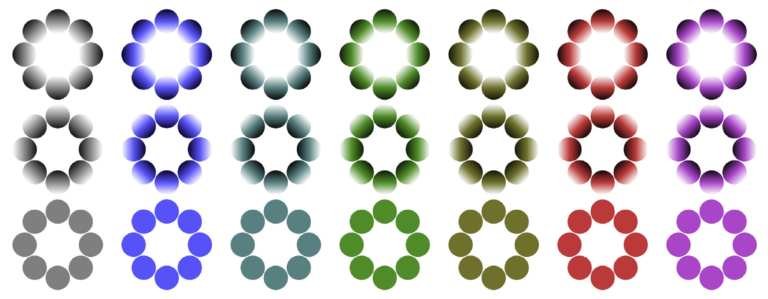
Part 2:
States & traits of the observer (internal factors)
9) Dark adaptation
Adaptation to low light levels increases susceptibility to being dazzled. The visual system can adapt to a remarkable range of light levels, but only relatively slowly and somewhat uniformly throughout the visual field.
One consequence of this is called the range effect: a greater range of oncoming headlight intensities reduces reported glare from a given source.
Short wavelength light can prevent / reverse dark adaptation the most efficiently, with obvious implications to headlight color. Similarly, a driver surrounded by digital displays (with inherently “blue” backlighting) inside the car will be in a less dark-adapted state, thereby reducing his glare sensitivity – and also his visual performance. Mitigation attempts against this issue are gradually getting more serious: dark mode for displays is offered on more and more models, and OLED screens finally reaching car interiors can make these attempts more effective. On the other hand, lowering of color temperatures of headlights is not yet in sight.
10) Optical properties of the eye
Light is filtered, diffracted, and scattered by various parts of the eye, and there are individual differences in these properties. Light iris color, a more light-permeable eyewall, or changes in various parts of the eye e.g. due to aging increase intraocular straylight, thereby increasing (primarily disability) glare. There are further inter-individual differences in how much this effect depends on the wavelength of light. On the other hand (and as typical with aging) a decrease in transparency and yellowing of the lens as well as a smaller pupil can decrease (primarily discomfort) glare.
11) Gaze position
Light projected to the fovea is more glaring than when it is aimed at peripheral parts of the retina (all else being equal); that is, glare depends on where we look. Have you ever been told not to look into the headlights of an oncoming vehicle? Such instructions are basically pointless – here are a few reasons why:
(i) Gaze behavior is often unconscious. The location of attention and gaze position are sometimes the same, sometimes not. The tricky part is that we often think that we looked to where we attended when actually that was not true – and the only way to figure this out is to have some external measure at hand. We see this often during psychophysical experiments: some people genuinely believe that they are steadily fixating on the fixation point, while the eye tracker shows that their gaze is all over the place.
(ii) Low-level saliency (like brightness or color contrast) is a primary driver of gaze behavior. The more glaring a light source, the quicker we will stare straight at it (unconsciously of course).
(iii) In night-time traffic, the only visible parts of a vehicle may be its lamps. Although they provide very little information regarding identity, direction, or depth (and thus, regarding location and velocity), we must look at them to extract the most information that is available.
(iv) When we can see more of the vehicle than only its lamps, object-based saliency has a greater chance to overwrite low-level saliency and thus help avoid gazing directly at the glare source. This process could be mimicked in total darkness too by providing lamps to facilitate perceiving the vehicle as an object (instead of just a bright dot) and to provide fixation locations away from the main glare source. (More on this here and here.)
(v) Indicator lamps are usually located just adjacent to other lamp types. To make sure of the turning intent of road users, we have to gaze at the assumed location of turn signal lights (i.e. by glaring headlamps or DRLs) until we either see the signal or can safely assume that we looked long enough to see it, if it was there (that takes up to ~1 s).

12) Attention and cognitive context
Attention enhances what we see – this appears to also affect glare perception. In a positive feedback loop, those who are sensitive to glare will pay more attention to it and thus increase it perceptually. Such top-down effects can reach lower level responses too, like those of the pupil: e.g. when we look at a picture of the sun, the pupil constricts more than in case of appropriate control images [here, here, and here].
13) Overreliance on the blink reflex
The blink reflex is commonly assumed to protect us from staring too long at a powerful light source. This assumption is erroneously overgeneralized: people can keep their eyes on extremely bright sources without an aversion response – particularly when the resulting retinal image is small.
14) Sensitivity to pattern glare
Even in lack of excessive brightness, certain patterns can be glaring to those who are sensitive to them. A common thread behind the sensitivity to different types of glare and flicker (and, possibly, the top-down effects on these) is cortical excitability.
15) Color preference
Interestingly, for some individuals the above sensitivity can be reduced by a certain color. The mechanism behind shorter wavelengths causing more glare (as mentioned in point 4) is universal: these wavelengths have a higher propensity to cause harm to the retina. Regarding pattern glare and color preference, however, personal preference varies and is probably based on a different mechanism.
16) Filling-in effect
Perceptually, edges tend to “own” the object that they surround, leading to incidental assumptions about the object’s properties. Such completion mechanisms affect color and brightness perception as well, even when the contours do not fully enclose the associated central space. Though I haven’t seen a study looking at this specifically for automotive applications, many DRL and tail lamp configurations might induce a change in perceived color or brightness of the inner surface of the lamp. E.g. the “dirty” yellow of a halogen headlight probably looks “cooler” if it is surrounded by blue LED DRLs 🙂
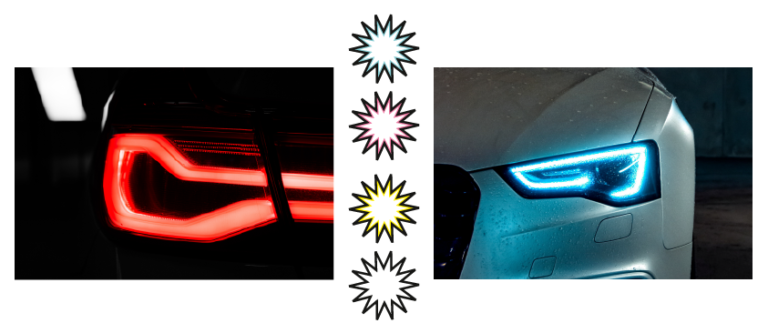
+1) Duration of exposure
This one is quite trivial (longer exposure is more likely to cause glare) and both external and internal factors can influence it. E.g., characteristics of eye movement behavior and attentional capture (when attention is involuntarily drawn to a stimulus) result in longer fixations on a light source when it is more salient. Similarly, absence of an assumed blink response would also increase the exposure duration.
Perceived glare is noticeably connected to exposure duration in case of adaptive driving beam systems: these attempt to detect other road users and (fully or partially) switch off the high beam to reduce glare. This process is unreliable – and when successful, it is reliably slower than human action (at least for now). While humans anticipate the other vehicle from seeing its headlight beam first, computer vision algorithms look for patterns associated with the vehicle itself. A weaker / less prototypical pattern (like a car with weaker headlights, or a motorbike) is less likely to be detected and a larger number of visible objects make detection slower. Owing to a fixed scanning direction of the detector, such systems can also be overwhelmed on the prioritized visual field, leaving no resources for other parts of the space. Eventually (depending on the success of this process) oncoming drivers are dazzled for a shorter or longer duration (few hundred ms to a couple of s) before the high beam is switched off.
+1 more) Flicker
Flicker is problematic for several reasons like phantom arrays, mislocalization around eye movements, decreased perceptual performance, or nervous fatigue through phase-locked neural reaction, contributing to headaches and seizures. Since these effects cause discomfort already on their own, it is difficult to tell whether they also do that through an increase in glare (and, to my knowledge, this specific question has not been studied in isolation). Theoretically though flicker might increase glare, possibly of both kinds mentioned in the Introduction.
There are two reasons for this.
- The luminance of a flickering source is usually defined as its average luminance across several cycles, based on the assumption that this is also how we perceive it. This is only approximately correct and flickering sources generally appear brighter. The difference might be negligible for most applications and situations.
- During rapid eye movements, however, the difference between the “on” and “off” phases of the modulation cycle of a small source becomes apparent (phantom array), resulting in higher contrast relative to an equally bright but continuous source.

Final thoughts
Glare is also affected by society in many ways. Demographics influence the optical properties of the average eye, the range effect and our habits regarding digital displays, or the latitude at which we live, alter our sensitivities and thereby also our judgments of a given light source. Plus, emotional values are attached to certain technologies, leading to customary adjectives like “dirty” halogen and “cool” LED.
My intention here was mainly to highlight the complexity of the question. In this topic, arguments and even conclusions are often based on only a few of the above points. This may be because those who are interested in lighting tend to focus on the technical side (primarily Part 1 of this post), while those who understand the factors in the second part tend not to care much about glare or lighting… It would be great to see more communication between these areas.
While I did hint at some solutions, there is much more to discuss there and I will do my best to get back to it soon. Till then, keep digging in the literature 🙂
[By the way, many of the links in this post are not open access. If you need access and aren’t using it already, I would recommend sci-hub (currently under a .se domain) – or just drop me an email.]